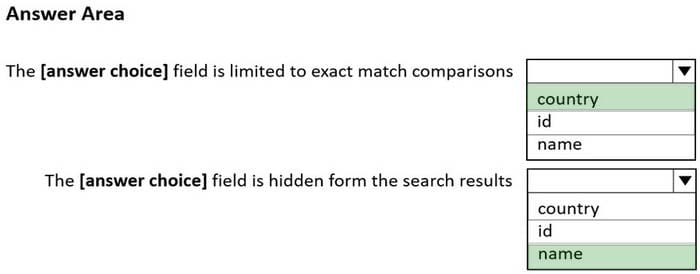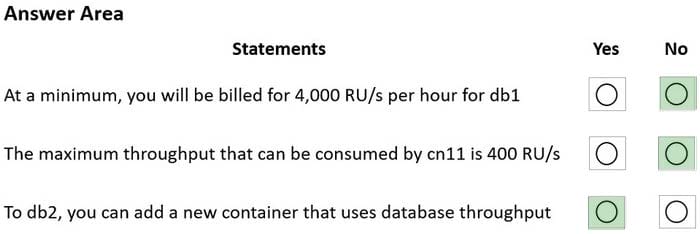Exam Details
Exam Code
:DP-420Exam Name
:Designing and Implementing Cloud-Native Applications Using Microsoft Azure Cosmos DBCertification
:Microsoft CertificationsVendor
:MicrosoftTotal Questions
:176 Q&AsLast Updated
:Jun 23, 2025
Microsoft Microsoft Certifications DP-420 Questions & Answers
-
Question 81:
HOTSPOT
You have three containers in an Azure Cosmos DB Core (SQL) API account as shown in the following table.

You have the following Azure functions:
1.
A function named Fn1 that reads the change feed of cn1
2.
A function named Fn2 that reads the change feed of cn2
3.
A function named Fn3 that reads the change feed of cn3 You perform the following actions:
1.
Delete an item named item1 from cn1.
2.
Update an item named item2 in cn2.
3.
For an item named item3 in cn3, update the item time to live to 3,600 seconds.
For each of the following statements, select Yes if the statement is true. Otherwise, select No.
NOTE: Each correct selection is worth one point.
Hot Area:

-
Question 82:
HOTSPOT
You configure Azure Cognitive Search to index a container in an Azure Cosmos DB Core (SQL) API account as shown in the following exhibit.

Use the drop-down menus to select the answer choice that completes each statement based on the information presented in the graphic.
NOTE: Each correct selection is worth one point.
Hot Area:
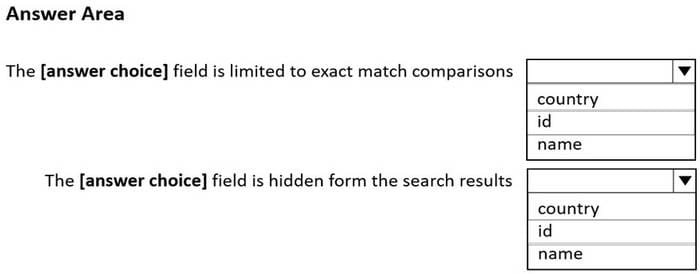
-
Question 83:
HOTSPOT
You have an Azure Cosmos DB Core (SQL) API account named storage1 that uses provisioned throughput capacity mode.
The storage1 account contains the databases shown in the following table.
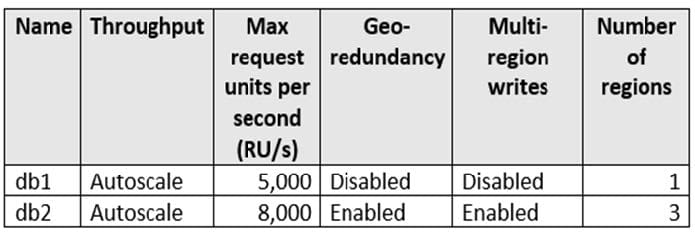
The databases contain the containers shown in the following table.
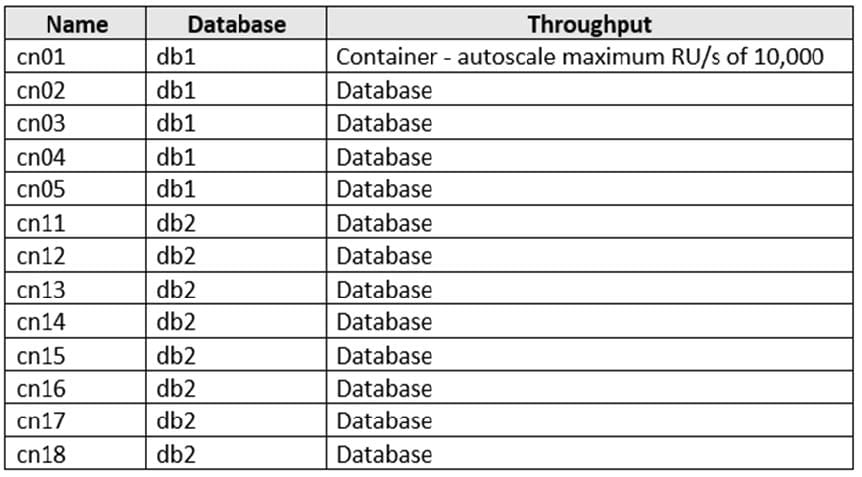
For each of the following statements, select Yes if the statement is true. Otherwise, select No.
NOTE: Each correct selection is worth one point.
Hot Area:
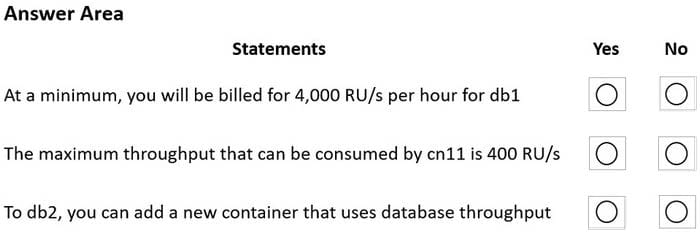
-
Question 84:
HOTSPOT
You have a database named telemetry in an Azure Cosmos DB Core (SQL) API account that stores IoT data. The database contains two containers named readings and devices.
Documents in readings have the following structure.
1.
id
2.
deviceid
3.
timestamp
4.
ownerid
5.
measures (array)
-type
-value
-metricid
Documents in devices have the following structure.
id deviceid owner
- ownerid
-emailaddress
-name brand model
For each of the following statements, select Yes if the statement is true. Otherwise, select No.
NOTE: Each correct selection is worth one point.
Hot Area:

-
Question 85:
You are troubleshooting the current issues caused by the application updates.
Which action can address the application updates issue without affecting the functionality of the application?
A. Enable time to live for the con-product container.
B. Set the default consistency level of account1 to strong.
C. Set the default consistency level of account1 to bounded staleness.
D. Add a custom indexing policy to the con-product container.
-
Question 86:
You need to select the partition key for con-iot1. The solution must meet the IoT telemetry requirements. What should you select?
A. the timestamp
B. the humidity
C. the temperature
D. the device ID
-
Question 87:
You configure multi-region writes for account1.
You need to ensure that App1 supports the new configuration for account1. The solution must meet the business requirements and the product catalog requirements.
What should you do?
A. Set the default consistency level of account1 to bounded staleness.
B. Create a private endpoint connection.
C. Modify the connection policy of App1.
D. Increase the number of request units per second (RU/s) allocated to the con-product and con-productVendor containers.
-
Question 88:
You need to provide a solution for the Azure Functions notifications following updates to con-product. The solution must meet the business requirements and the product catalog requirements. Which two actions should you perform? Each correct answer presents part of the solution. NOTE: Each correct selection is worth one point.
A. Configure the trigger for each function to use a different leaseCollectionPrefix
B. Configure the trigger for each function to use the same leaseCollectionName
C. Configure the trigger for each function to use a different leaseCollectionName
D. Configure the trigger for each function to use the same leaseCollectionPrefix
-
Question 89:
You need to identify which connectivity mode to use when implementing App2. The solution must support the planned changes and meet the business requirements. Which connectivity mode should you identify?
A. Direct mode over HTTPS
B. Gateway mode (using HTTPS)
C. Direct mode over TCP
-
Question 90:
You need to implement a solution to meet the product catalog requirements. What should you do to implement the conflict resolution policy.
A. Remove frequently changed field from the index policy of the con-product container.
B. Disable indexing on all fields in the index policy of the con-product container.
C. Set the default consistency level for account1 to eventual.
D. Create a new container and migrate the product catalog data to the new container.
Related Exams:
62-193
Technology Literacy for Educators70-243
Administering and Deploying System Center 2012 Configuration Manager70-355
Universal Windows Platform – App Data, Services, and Coding Patterns77-420
Excel 201377-427
Excel 2013 Expert Part One77-725
Word 2016 Core Document Creation, Collaboration and Communication77-726
Word 2016 Expert Creating Documents for Effective Communication77-727
Excel 2016 Core Data Analysis, Manipulation, and Presentation77-728
Excel 2016 Expert: Interpreting Data for Insights77-731
Outlook 2016 Core Communication, Collaboration and Email Skills
Tips on How to Prepare for the Exams
Nowadays, the certification exams become more and more important and required by more and more enterprises when applying for a job. But how to prepare for the exam effectively? How to prepare for the exam in a short time with less efforts? How to get a ideal result and how to find the most reliable resources? Here on Vcedump.com, you will find all the answers. Vcedump.com provide not only Microsoft exam questions, answers and explanations but also complete assistance on your exam preparation and certification application. If you are confused on your DP-420 exam preparations and Microsoft certification application, do not hesitate to visit our Vcedump.com to find your solutions here.

